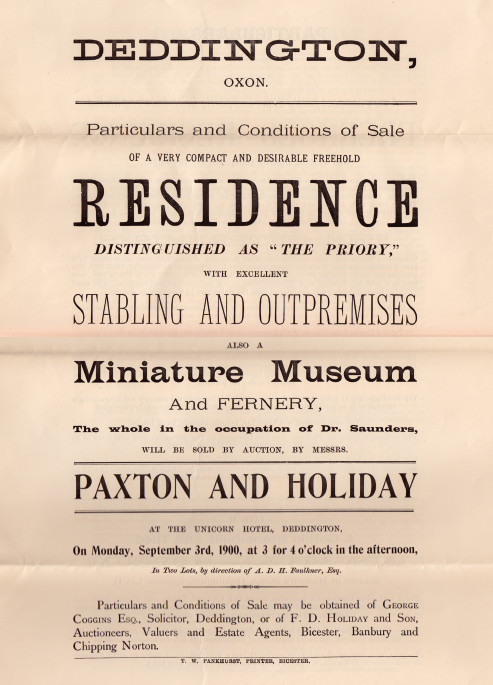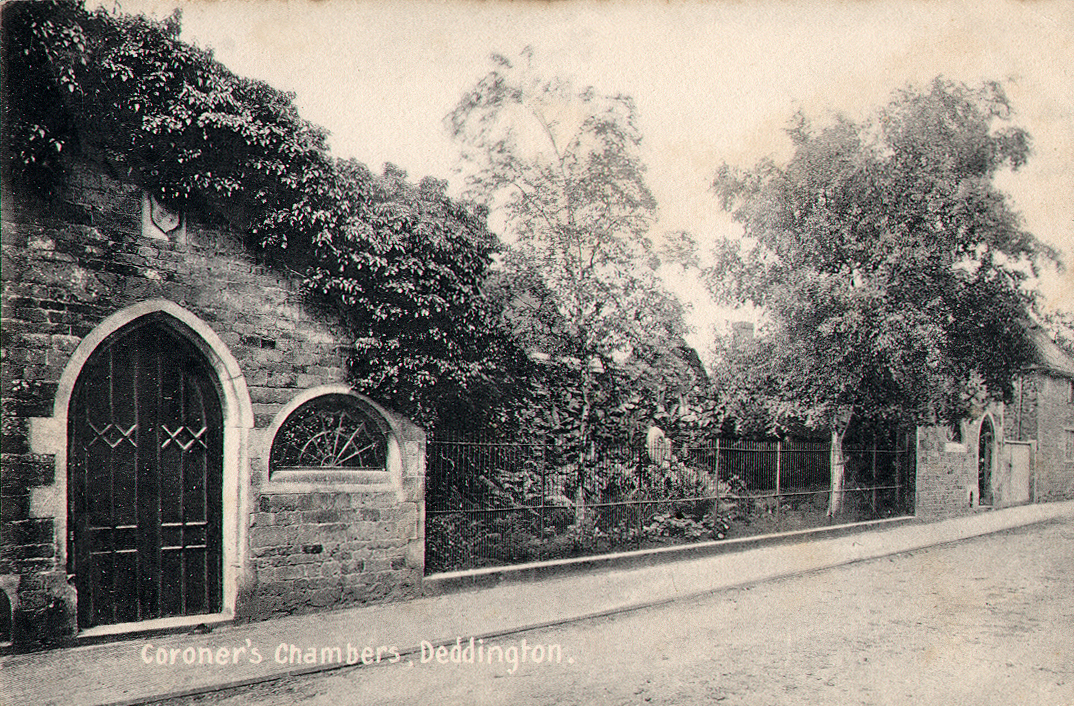Millennium Project
David French
The history of this nineteenth century private museum is a little confused as Charles Faulkner and his son Charles Duffell Faulkner have been conflated in various sources including the Victoria County History, Pevsner’s Architectural Guides, Mary Vane-Turner’s The Story of Deddington (1933) and the Deddington Map Group’s Discovering Deddington.
Charles Faulkner (born 1798, the son of the Rev. John Faulkner, Vicar of Deddington 1790-1821), established a private museum opposite the house he (re)built at The Priory in Hudson Street (then Hudson's Lane), following his return to Deddington from Adderbury in 1844.
He was a passionate antiquarian and was elected a Fellow of the Society of Antiquaries of London in 1858. He was a founder member in 1853 of 'The North- Oxfordshire Archæological Society'.
Faulkner delighted in displaying curiosities from his museum at antiquarian meetings such as those of the North-Oxfordshire Archæological Society, the Buckinghamshire Architectural and Archæological Society, and The Archæological Institute of Great Britain and Ireland. A flavour of the contents of his museum may be gleaned from the below press reports in 1853 and 1855.
Charles Faulkner also used to display items from his museum, which was not limited to antiquities, at the annual Deddington Horticultural Society Show, usually held in the Castle Grounds. In 1850 he exhibited 30 specimens of wheat, maize and oats, grown by various nations which traded with Great Britain. At the 1853 show he exhibited a vase, framed by small ferns, containing a variety of diminutive fish and shells. "This very pretty contribution was from the museum of C. Faulkner Esq."
When a rare locust was captured in a field near Deddington in 1849, it was taken to Mr. Faulkner's museum.
The museum was immediately opposite The Priory on the north side of Hudson Street (now occupied by the Cyclogical Shop and Medipill). In 1900 auction particulars, it is described as:

Lot 1 of the particulars concerning The Priory itself and its 'outpremises' includes reference to a "Coachhouse and large Room over, the whole 45ft. x 16ft., now used as a Loft, but formerly as a Museum".
Mary Vane-Turner says that Charles Faulkner's curiosities "were on show in the roomy upper part of the house to which admission was free".
It is conceivable that these other two locations, not necessarily contemporaneous, were whilst the museum was being constructed, or for temporary displays or overflow storage.
Click on the image (l) to see the full document (large pdf)
Charles Faulkner died in 1871. His son, Charles Duffell Faulkner (born 1827), who inherited The Priory, was a prominent local solicitor, as well as a militant advocate for the temperance movement. He was also Coroner for North Oxfordshire 1870- 92, when he retired due to ill health. The Coroner's Chambers were housed in The Priory. He died near Tunbridge Wells in 1894.
It seems that the contents of Charles Faulkner's museum were largely dispersed following his death in 1871 (see press extracts below). The Banbury Advertiser says they were acquired by the 'Oxford Museum' (presumably the Ashmolean), while Mary Vane-Turner, who also conflates Faulkner father and son, says the collection was dispersed to various London museums.
One half of the front of the museum survives. Its features include a stone plaque bearing the initials "C.D.F", suggesting C.D. Faulkner continued to maintain some sort of private collection there. Even today a number of fossils, gargoyles and other relics, can still be found in the little garden and grotto behind the Cyclogical Shop. Insert Images
Newspaper transcripts
8 December 1853, Banbury Guardian
"First general meeting of North Oxfordshire Archǣological Society at Banbury. Good attendance of ladies and gentlemen. Mr. C. Faulkner exhibited a collection of Roman remains from his museum at Deddington, among which were - A bronze head, probably of Venus, the weight of a staters or steelyard, discovered, with a coin of Constantinus, in a field on the north-east side of Adderbury turnpike; bronze celt, found at Dean Hill, near North Aston; part of a gold chain, of Roman workmanship, found in a field near Barford St. Michael's; fragment of a fictile vessel, dug up during the excavation of the hypocaust, at Wigginton, A.D. 1824; fragments of tesselated pavements, painted plaster, flues, charred wheat and vetches, &c., from the Roman villa near Stonesfield; bronze lamp for suspending from the ceiling, fibulǣ, stylus, dog, dove, mermaid, and a female head used as a weight for a small balance, from Kingsholm, near Gloucester. Comments by Mr.Faulkner about reforming law on treasure trove."
4 August 1855, Oxford Chronicle
This extract is from a lengthy report (4 columns) on a 2-day annual meeting in Buckingham Town Hall of the Bucks Architectural and Archǣological Society. It contains detailed description of 12 curiosities exhibited by C. Faulkner, Esq. of Deddington (2nd column), including (amongst other things) "a sacring bell, found built in the wall which blocked up a circular-headed window over the south entrance of Deddington church; a small crucifix, dug up in a field near Deddington; and a stand for the hour-glass formerly placed in the pulpit in Deddington Church, agreeably to a custom introduced before 12th Eliz. (1569) for regulating sermons."
14 September 1871, Banbury Advertiser
Extract from report on death of Mr. Charles Faulkner: "He had an extensive collection of antiquarian and geological specimens, which will now probably become the property of the Oxford Museum."
1st February 1894, Banbury Advertiser
Extract from obituary of Charles Duffell Faulkner: "The father of the deceased was Mr. Charles Faulkner, who was well known as a member of the Archaeological Society, and who on his death, which happened suddenly in 1871, bequeathed a portion the contents of his museum at Deddington to the Oxford Museum."
The Story of Deddington by Mary Vane-Turner, 1933 - 5. Deddington Folk
"Mr. C. Duffell Faulkner, Solicitor, dwelt first at 'Gegg's Hook' by Deddington cross roads, and then removed to Hudson's Lane, named it is true after the Hudson who gave the church clock, but ever famous for Faulkner's residence and museum at 'the Priory' which he rebuilt."
"As antiquarian and collector he earns respectful comment from contemporary writers. The museum of local curiosities which he collected — pre-historic and of every period — were on show in the roomy upper part of the house to which admission was free, Mr. Faulkner having no other object but to interest others in his valuable hobby. At his death the collection was dispersed to various London museums, but some fine fossils — notably a huge ammonite — gargoyles and other relics, still adorn the little garden and grotto opposite his old house, which also contains inside and out, various small sculptures, from angels to grotesques, evidence of his ruling passion."
Victoria County History, Volume 11, 1983
Extract from chapter on Parish of Deddington: "On the north side of the street [Hudson Street] is a small building erected by C. D. Faulkner, F.S.A. (d. 1871) as a private museum, of which the contents have been dispersed; Faulkner also rebuilt and lived in the house opposite, called the Priory8* "
*fn.90. Proc. Soc. Antiq. 2nd ser. v. 307 (obituary); Turner, Deddington, 49–50.
Pevsner - Oxfordshire: North and West - 2017 revision
Extract from Deddington entry (page 294): "At the start of HUDSON STREET, leading back E to the Market Place, an early Victorian interlude, S side: THE PRIORY, stone, perhaps c.1850, with gables and Tudor-arched windows with hoods on diamond stops, and Nos. 2-3, an unequal semi-detached pair, probably c.1841, of brick, with elaborate Gothick iron-latticed windows. All were (re)built around a late C17 core, for the antiquary Charles D. Faulkner, whose private museum (now a shop) stood opposite. At the rear of the houses are the dates 1690, 1841, 1851 and 1854; also, reset in the back wall of The Priory, a cinquefoil-headed niche of c.1300."
